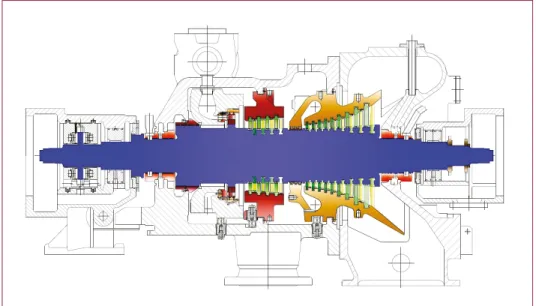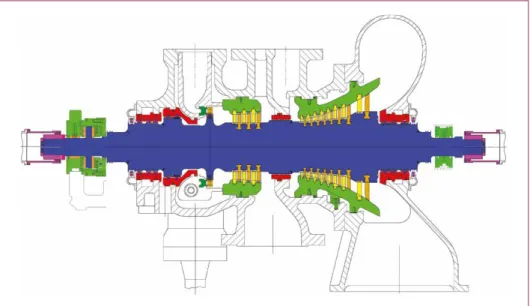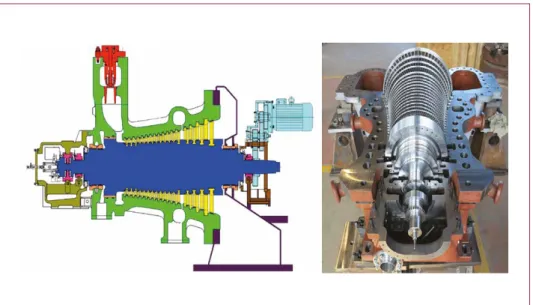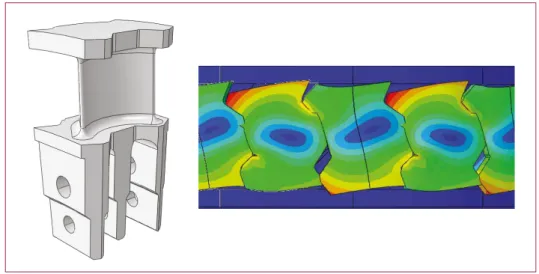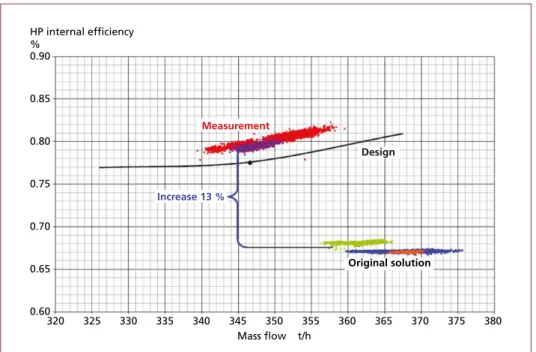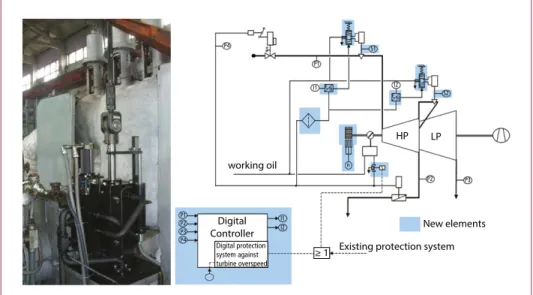Adapting for the Future: Bringing New Life to Industrial Steam Turbines in Changing Markets
Dariusz Knitter
In response to:
• continuous changes in requirements in various industrial markets,
• changes in external requirements (such as regulatory changes or market restructu- ring), and/or changes in individual plant requirements,
GE delivers worldwide economically viable solutions for industrial plants, like modern upgrades and retrofits of steam turbines based on partial or full steam path replacement adapted to remained key capital turbine components (casted casings) and plant equip- ment. Therefore, next to the construction of new industrial plants, which requires huge amounts of investments, upgrading and retrofitting of existing plants is in strong focus.
Typically, waste-to-energy plants are linked to district heating lines or there are ext- ractions to provide steam to adjacent industrial customers. The heat extraction is often valued more than the pure electrical power. Therefore, a modification of the existing steam turbine is desired to provide more heat power via the extractions, making waste- to-energy plants more profitable while achieving the best possible efficiency under the existing framework.
The benefits of such economic, technically optimized solutions, developed under strong co-operation with the customers, are:
• return of investment in one year instead of two,
• adaptations of existing steam turbines to flexible or new operational conditions of industrial plants, e.g. adaptations to heat demand for industrial process purposes,
• significant increase of plant and turbine cycle efficiency (up to 15 %) and the resul- ting reduction of live steam (up to 15 %) and fuel consumption, as well as increase of production (electric power for utility or ammonia, methanol, etc. for petrochemical industry),
• increase of plant lifetime and reliability.
All of the above-stated gains are based on solid simulation results, proven by years of suc- cessful achievement of guaranteed performance figures and lifetime extensions of a large amount of reference units installed already on-site and valued by customers worldwide.
The new aspect being presented here is the high degree of automation in the optimi- zation steps applied and the in-depth involvement of the customers in the individual optimization steps, providing solutions customized to meet their unique needs.
This paper provides concrete and specific referential examples dedicated for various industrial markets and customers. The applied technology can be adapted specifically to the requirements of waste-to-energy plants.
Optimierung und Betrieb
Dariusz Knitter
Optimierung und Betrieb
References on chemical and petrochemical industrial markets
In response of dynamic development of industrial market (especially chemical and pet- roleum industry, including ammonia and methanol production with syngas processing, as well) the company carried out effective revamps of steam turbines as compressor drives, which are very interesting from both commercial and technical point of view.
One of the main aims of upgrades of ammonia or methanol plants is production increasing with simultaneous reduction of live steam consumption taken into steam turbines. This is the main factor contributing to significant cost savings for customers.
In case of methanol plants, it was proved it is available to increase production from 750,000 tons/year to more than 1 million tons/year with live steam reduction even to 10 to 15 % (30 to 40 t/h). One such example involves the Tomsk plant in Russia. The facility’s machines originally were designed by Siemens (Wesel, EHNK type) and by former Nuovo Pignone (currently GE), based on Siemens license, as reaction extraction- condensing steam turbines.
Figure 1: EHNK-50/45 type of steam turbine (Siemens and former Nuovo Pignone – currently GE) after revamp
In case of ammonia plants, in the 1970s, a lot of installed plants were based on the ammonia production in the range of 1,360 tons/day. The first step of upgrade (the 80’
and 90’) allowed to increase production up to 1,700 tons/day.
Until now, many references (e.g. on Mitsubishi Heavy Industries, MHI, 5EH-6BD – the so-called 103JT type) for ammonia plants enabled an increase in production to above 2,000 tons/day.
Figure 2: MHI 5EH-6BD (103JT) steam turbine after revamp by GE (former Alstom)
In those cases (with turbo-compressors and syngas processes), the ammonia produc- tion increase was achieved with simultaneous reduction of live steam consumption (P100 steam) up to 12 to 18 t/h (6 %, new design to old design), while maintaining or increasing the amount of controlled bleed steam (P40 steam). In 2013 and 2014, GE (legacy Alstom that time) executed a few projects (revamps and complete new modules) of Fuji 101JT steam turbines (live steam supplied from controlled bleed of MHI 5EH-6BD /103JT) as air compressor drives, which allowed for increased air consumption for compressor processes and, in consequence, increased ammonia production.
Original MHI 5EH-6BD (103JT) were produced in 1976 as high-speed impulse extraction-condensing turbines driving three-casing syngas compressors (Dresser Rand in many cases).
The primary goals of those revamps included significantly reducing of the live steam flow, increasing turbine efficiency improving power output and adapting the new turbine to the existing arrangement (including decreasing the failure rate, which was a major problem of the original turbines, mainly last stage blades of original MHI 103JT steam turbines) and new conditions. Aside from the efficiency improvement, other goals were lifetime extension and maintenance interval elongation.
To help save customers money, it was important to design highly optimal turbines while keeping some original equipment (such as the outer casing, bearing pedestals, stop and control valves, turning gear, etc.). Important from an economical perspective, this provided for a return of investment in one to two years.
Optimierung und Betrieb
Dariusz Knitter
Optimierung und Betrieb
In case of customized adaptations of new turbines to specific and flexible conditions (as in those cases), it was necessary to disregard some well-known standards and create new designs according to specific customer requirements.
Some time ago, the impulse turbine type was popular, especially in eastern CIS coun- tries such as Russia (companies like LMZ, NZL, ChTGZ / TA, etc.), Asia – e.g. Japan (MHI, Toshiba, etc.), China (Harbin, Shanghai, Wuhan, Nanjing companies, etc.), and in the U.S. market (for example Westinghouse) and reaction types especially in Europe (BBC / ABB, Siemens).
In the 1980s and 1990s, one could notice very strong development of turbomachinery know-how all around the world, especially in European countries (Switzerland, Ger- many, Poland, UK, France, Sweden and others) which allowed to install thousands retrofits and modernized steam turbines in the world. As a result reaction blading technology was developed significantly (ABB, Siemens, Alstom and others). On this consistent way nowadays high efficient and reliable reaction steam turbines for all relevant markets are offered.
Figure 3: Fuji 101JT steam turbine after revamp
The concept of reaction blading was also kept in case of revamped Siemens EHNK- 50/45 and Fuji 101JT steam turbines, as mentioned above.
On the other side, the company offers also highly developed impulse blading technology for very small, medium and large steam turbines (including nuclear steam turbines).
Both technologies are offered, depending on thermodynamic parameters (load), turbine size and arrangement (e.g. distance between bearings, etc.).
Figure 4: Stationary and moving blade of the reaction turbine (on the left) and assembly view of moving blades (on the right)
Also conversion of technology from impulse to reaction can be offered, for example, only if it is beneficial. This is the case with the revamped MHI 5EH-6BD (103JT) steam turbine, for which impulse blading was replaced by reaction one.
Figure 5: Developed impulse moving blade for control stage with reliable zig-zag shroud and platform
Another modification was in the low pressure section, where the low pressure (LP) control stage was eliminated (in order to increase efficiency) and throttle control (with full arc steam admission) was applied.
Another advanced solution was applied on the balance piston – a honeycomb type, highly developed seal, which considerably minimizes steam leakage (radial clearance 0.15 mm). Axial and radial clearances in the blading and sealing system are properly established to avoid any rubbings and failures across the operational range (with
Optimierung und Betrieb
Dariusz Knitter
Optimierung und Betrieb
consideration of start-ups and shut-downs of the turbo-compressor). High-speed balance tests indicated very good dynamic state for all of those proposals (vibration values much less than with original rotors). This solution enables safe and long-term high-efficient operation of modernized turbine.
In the case of revamped MHI 5EH-6BD (103JT) and Siemens EHNK-50/45 steam turbines, it was necessary to maintain the concept of a full controlled steam extraction.
The pressure value in extraction is controlled automatically by LP control valves – aligned with original control system(s) or with Electro-Hydraulic Control System. In such situations, steam flow to the LP part is automatically controlled in a wide range of operations.
The main result of the above-outlined revamp (confirmed on the performance measu- rements on sites, as in Figure 6) is a 6 % reduction of the live steam flow (the increase of efficiency) for a modernized 103JT turbine. Additional results include a significant reduction of steam and fuel consumption (for example, natural gas, coal, oil, naphtha etc.) – consistently connected with a significant increase of ammonia or methanol production.
Another benefit is an increase of maximal power output. In the case of an MHI 103JT steam turbine, the unit’s output was about 30 MW with 380 t/h of the maximal live steam flow before modernization and 32.5 MW with 366 t/h of the maximal live steam flow at the same conditions following the upgrade. Such beneficial modernization is much more attractive from the customer’s point of view than other competitors, who offer only 2.5 % reduction of the live steam flow.
HP internal efficiency
% 0.90
0.85
0.80
0.75
0.70
0.65
0.60
Mass flow t/h
320 325 330 335 340 345 350 355 360 365 370 375 380
Increase 13 %
Design
Original solution Measurement
Figure 6: Results of performance tests, e.g. for HP (high pressure) part of the turbine; internal
In case of EHNK-50/45 turbine modernization, an increase of maximal power output from 34.9 MW to 39.4 MW (about 12 % increase) enables of increased methanol production.
Figure 7: Results of performance tests, e.g. for HP (high pressure) part of the turbine; power increase (10 %)
Power MV 21.000
20.000
19.000
18.000
17.000
16.000
15.000
Mass flow t/h
320 325 330 335 340 345 350 355 360 365 370 375 380
Delta Power = 3.2 MW Design (guaranteed point)
Measurement after retrofit Measurement
after retrofit
Figure 8: Electro-hydraulic control system diagram (on the left) and modern actuator for one of
working oil
HP LP
New elements Existing protection system
≥ 1 Digital
Controller
Digital protection system against turbine overspeed P1
P2 P3 P4
I1 I2
P2 P3 n
I2 E H S2 E H
I1 P1 P4 S1
Optimierung und Betrieb
Dariusz Knitter
Optimierung und Betrieb
Consequently, those upgrades resulted in fewer emissions with the same output – a very important outcome in a carbon-constrained market.
There is an additional opportunity to modernize the by implementing an automatic electro-hydraulic system with a digital controller (with of the option to include suction pressure control on the compressor as anti-surge control). This freely programmable digital controller with redundancy controls steam extraction pressure and revolution speed. The package also includes actuators and linear controllers that move sliders or actuators. Currently such options are offered as well-developed standard packages for industrial steam turbines around the world.
Conclusions
Faced with changes in requirements, regulations and restructuring impacting world- wide industrial markets, many concrete customers in various regions are today seeking innovative and economical solutions to maintain the viability of existing industrial plant assets. Rather than incurring significant capital investments associated with constructing new plants, the current focus is largely on identifying cost-effective, technically optimized solutions for existing assets that provide for a one- to two-year return on investment.
The key to delivering solutions for steam plant operators is helping them improve performance while, at the same time, reducing or maintaining low emissions. Using the latest technologies, many operators can now upgrade their existing steam turbines to increase flexibility and adapt to the new operational conditions of industrial plants, such as the need to provide heat for industrial processes. With the capability to provi- de total plant solutions for 90+ OEM brands using data-driven insights, customized solutions can be identified to help operators increase plant and turbine cycle efficiency by up to 15 percent while reducing live steam and fuel consumption and increasing electricity or chemical production. In addition to these near-term benefits, upgrades such as these can provide operators a more reliable plant with a longer expected life.
Bibliografische Information der Deutschen Nationalbibliothek Die Deutsche Nationalbibliothek verzeichnet diese Publikation in der Deutschen Nationalbibliografie; detaillierte bibliografische Daten sind im Internet über http://dnb.dnb.de abrufbar
Stephanie Thiel, Elisabeth Thomé-Kozmiensky, Peter Quicker, Alexander Gosten (Hrsg.):
Energie aus Abfall, Band 15
ISBN 978-3-944310-39-8 Thomé-Kozmiensky Verlag GmbH
Copyright: Elisabeth Thomé-Kozmiensky, M.Sc., Dr.-Ing. Stephanie Thiel Alle Rechte vorbehalten
Verlag: Thomé-Kozmiensky Verlag GmbH • Neuruppin 2018
Redaktion und Lektorat: Dr.-Ing. Stephanie Thiel, Elisabeth Thomé-Kozmiensky, M.Sc., Dr.-Ing. Olaf Holm
Erfassung und Layout: Ginette Teske, Sandra Peters, Janin Burbott-Seidel,
Claudia Naumann-Deppe, Cordula Müller, Anne Kuhlo, Gabi Spiegel Druck: Universal Medien GmbH, München
Dieses Werk ist urheberrechtlich geschützt. Die dadurch begründeten Rechte, insbesondere die der Übersetzung, des Nachdrucks, des Vortrags, der Entnahme von Abbildungen und Tabellen, der Funk- sendung, der Mikroverfilmung oder der Vervielfältigung auf anderen Wegen und der Speicherung in Datenverarbeitungsanlagen, bleiben, auch bei nur auszugsweiser Verwertung, vorbehalten. Eine Vervielfältigung dieses Werkes oder von Teilen dieses Werkes ist auch im Einzelfall nur in den Grenzen der gesetzlichen Bestimmungen des Urheberrechtsgesetzes der Bundesrepublik Deutschland vom 9. September 1965 in der jeweils geltenden Fassung zulässig. Sie ist grundsätzlich vergütungspflichtig.
Zuwiderhandlungen unterliegen den Strafbestimmungen des Urheberrechtsgesetzes.
Die Wiedergabe von Gebrauchsnamen, Handelsnamen, Warenbezeichnungen usw. in diesem Werk berechtigt auch ohne besondere Kennzeichnung nicht zu der Annahme, dass solche Namen im Sinne der Warenzeichen- und Markenschutz-Gesetzgebung als frei zu betrachten wären und daher von jedermann benutzt werden dürfen.
Sollte in diesem Werk direkt oder indirekt auf Gesetze, Vorschriften oder Richtlinien, z.B. DIN, VDI, VDE, VGB Bezug genommen oder aus ihnen zitiert worden sein, so kann der Verlag keine Gewähr für Richtigkeit, Vollständigkeit oder Aktualität übernehmen. Es empfiehlt sich, gegebenenfalls für die eigenen Arbeiten die vollständigen Vorschriften oder Richtlinien in der jeweils gültigen Fassung
